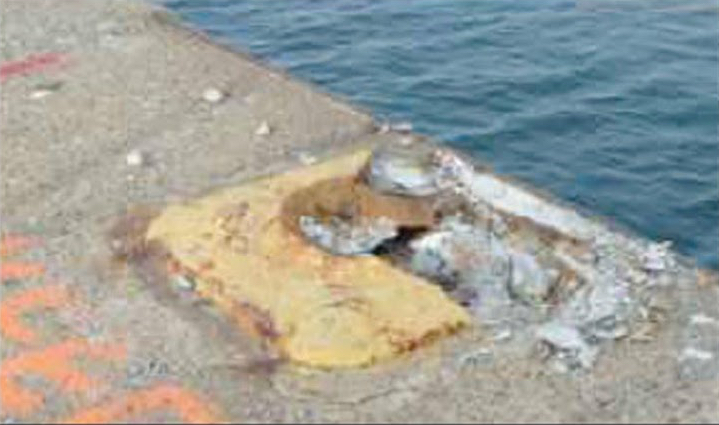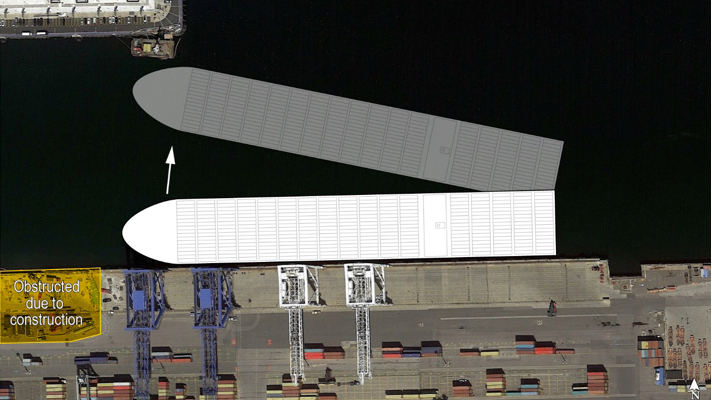Panama-flagged container ship Helsinki Bridge secured five of its head lines on one mooring bollard in the port of Boston. The bollard consequently failed, after which the vessel went adrift and hit a cruise terminal pier.
The incident took place on 6 December 2017, at 0003 local time, while the Helsinki Bridge was moored in the Reserved Channel port side to the Paul W. Conley Container Terminal in Boston, Massachusetts. The US National Transportation Safety Board (NTSB) investigated the incident, which was also featured in the latest Mars Report.
Construction Fence Limits Amount of Bollards
Crew were berthing the container vessel after it had just arrived in port. Linesmen ashore were placing the mooring lines on bollards. Strong winds were forecast, so the master and pilot agreed to use fourteen lines in total, including five headlines. Some of the bollards could not be used because they were forward of a construction fence, so all five headlines were placed on the same bollard just forward of the bow.
 Failing Bollard Causes Other Lines to Part
Failing Bollard Causes Other Lines to Part
As the vessel was discharging cargo, winds increased as expected with peak gusts near 40 knots. The bollard forward with the five headlines was torn from its base. The forward spring lines parted followed in quick succession by the remaining lines. The vessel drifted off the wharf and the bow struck the Raymond L. Flynn Black Falcon Cruise Terminal pier.
Failed bollard.
Tugs Assist Vessel back to Anchorage
An anchor was walked out, bow thruster and main engine were brought on line and the uncontrolled drift of the vessel was stopped some thirty minutes after the bollard failure. Shortly afterwards, tugs arrived and assisted the container vessel to anchorage.
No Injuries; Serious Damage
There were no reports of pollution and no injuries among the 24 crewmembers and ten longshoremen on board. The damage was estimated at $ 570,000 for the vessel and $ 40,500 for both terminals.
NTSB Says Port Authority and Captain to Blame
The NTSB has determined that the probable cause of the breakaway of the containership Helsinki Bridge and subsequent allision with the Black Falcon Cruise Terminal was the failure of the Massachusetts Port Authority to provide suitable berthing arrangements during ongoing construction at the Conley Container Terminal. This resulted in the overloading and failure of a single mooring bollard.
Contributing to the accident was the lack of preparation by the vessel’s master, who was aware of the less than suitable mooring arrangements and the deteriorating weather forecast, but took no mitigating action to address the situation.
Lessons Learned
- Mariners can never be sure of the holding power of a particular shore bollard. In this case, all forward headlines were on one bollard. Best practice is to spread the load to several bollards.
- Once one part of a mooring arrangement fails, there is a high probability of the remaining parts failing in relatively quick succession. Loads can be distributed in a way that is beyond the design capacity of the system.
- If high winds are forecast it may be necessary to take extra precautions, such as an anchor outboard, having engines and bow thruster ready, or having tugs on standby.
NTSB and Mars Report
The accident report has been based on NTSB report DCA18FM006 and Mars Report 201923. This is one of the April Mars Reports, that are part of Report Number 318. A selection of this Report has also been published in SWZ|Maritime’s May issue.
Acknowledgement
Through the kind intermediary of The Nautical Institute we gratefully acknowledge sponsorship provided by:
American Bureau of Shipping, AR Brink & Associates, Britannia P&I Club, Cargill, Class NK, DNV, Gard, IHS Fairplay Safety at Sea International, International Institute of Marine Surveying, Lairdside Maritime Centre, London Offshore Consultants, MOL Tankship Management (Europe) Ltd, Noble Denton, North of England P&I Club, Sail Training International, Shipowners Club, The Marine Society and Sea Cadets, The Swedish Club, UK Hydrographic Office, West of England P&I Club
Submit a Mars Report
More reports are needed to keep the scheme interesting and informative. All reports are read only by the Mars coordinator and are treated in the strictest confidence. To submit a report, please use the Mars report form and send it to mars@nautinst.org.








